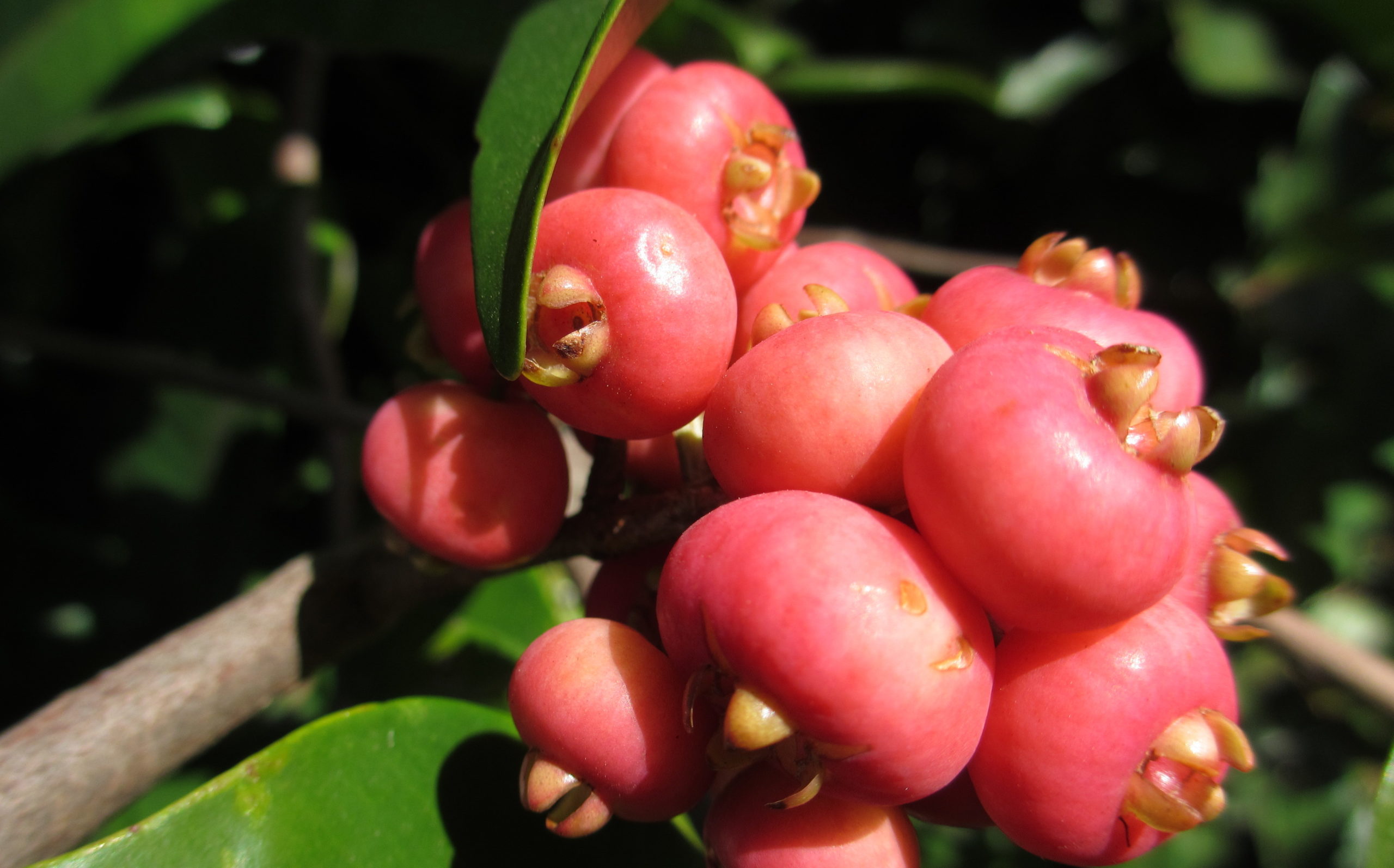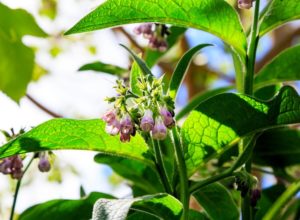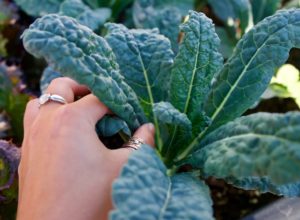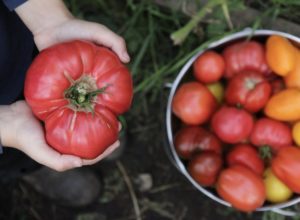[h4]MEDITERRANEAN climate[/h4]
Zone 0: Just when I ought to be getting my spring planting organised, I’m preoccupied with heading off for permaculture training – more on that later!
Zone 1: Raised garden beds have had a quick sprinkle of seeds for a few more leafy greens before they get warm enough for the solanum vegies. The white cabbage butterflies that seemed to have gone on holidays are back as if they just know. So vege-nets will need to go back on to protect those babies. Potato plants are really firing now – almost too fast for the woolly bear caterpillars, but it’s still worth catching and squishing them as they are such voracious eaters. I’ve just planted asparagus crowns, as deep as possible in a wicking bed, with their tentacles spread over little mounds of soil at the bottom and lots of compost and some chook manure mixed into the backfill soil to get them started. I’ll much with seaweed for both trace elements and a touch of salt, since they are partial to a little seasoning. Red Russian kale is making marvellous kale chips – this plant was self-sown, is remarkably caterpillar-resistant, and has provided protection for the early volunteer tomatoes – but the more hooked I get on those kale chips, the more kale I wish I had planted!
[Recipe: tear up clean, dry kale leaves into ‘chip’ sized pieces, toss them in a splash of extra virgin olive oil and a sprinkle of salt, spread out in a single layer on oven trays and bake about 5-10 min on 125C till just crispy. Sensational!]
And now it’s time to get organised for all those wonderful vegies to grow over spring and summer. Some, like beans, corn, zucchini, melons, gourds and pumpkin, would prefer to wait until the ground is warm enough for sowing directly in the soil. While you wait, sow beetroot, carrot, chicory, chives, coriander, corn salad, radishes, dill, endive, fennel, artichokes, kohlrabi, mustard greens, lettuces, parsnips, parsley, potatoes, rhubarb, rocket, silverbeet and its friends rainbow & ruby chard, snow peas, spring onions and turnips.
If you have any time and energy left after that lot, clean out some punnets or trays and sow seed under cover for basil, broccoli, cabbage, capsicum & chillies, celery & celeriac, eggplant, leeks, NZ spinach (Warrigal greens), tomato & tomatillo.
Zone 2: Self-sown sweet peas are now halfway up the fence and flowering. These are not only beautifully colourful and fragrant, but they make terrific pea straw mulch in summer when they’re finished. They pop up in many other parts of the garden these days – I either pull them up and transplant them to the fences or nip them off when I’m ready to use them as mulch, leaving the roots in the ground for nitrogen.
Compost worms are feeling spring coming on… it’s either that or the tons of coffee grounds in their diet, but they are having a breeding frenzy. Not only in worm farms but in Mum’s many compost bins. Chooks that have been off the lay should get back to work shortly (especially if they get hold of some of those worms!), and wild birds are busy gathering materials for their nests too.
Zone 3: Planted a beautiful multi-grafted cherry tree (Stella and Lapins) – an optimistic whim in the face of our ever-warming seasons, but one tempered with a little low-chill tolerance. And transplanted a couple of pear trees (20th Century nashi and Corella), again relatively tolerant of the warmth here.
Many stone fruit growers will be spraying now (at or just before bud burst) with various copper compounds to help prevent or reduce incidence of leaf curl. Of the most common treatments – copper oxychloride, cupric hydroxide and Bordeaux mixture – only the latter two are acceptable within organic systems and all may have harmful effects on bees, soil and worms. To reduce adverse impacts, spray when the weather is still and before blossoms have opened, and lay down ground sheets to reduce infiltration into the soil. Also maximise sun access and ventilation around trees and water strategically (e.g. drippers under mulch) to reduce lingering humidity during the growing season. Many choose not to spray and find that their trees still bear well in spite of leaf curl.
Zone 4: Invasive grasses have gone nuts here again… a reminder to plant out the gaps amongst the native ground covers (e.g. strike some cuttings from the creeping boobialla next autumn) and to slash and re-mulch over the grasses before they set seed!
Zone 5: I’m off over the horizon to NSW for some great permie upskilling with Milkwood’s Nick Ritar & Rosemary Morrow…looking forward to seeing varied landscapes along the way, bush camping, sharing with and learning from a very skilled and experienced batch of fellow students from many states and diverse backgrounds. Oh, I hear they have rain over there too J
Happy spring!
Nadja Osterstock
www.nadjasgarden.com.au
Facebook page: https://www.facebook.com/pages/Nadjas-Garden/147773922060096
[h4]WARM TEMPERATE climate[/h4]
Every year we have a false spring. My spirits soar and I am excited to the young buds forming but I remind myself they will be blown off by that last snap of winter and then true spring emerges.
Zone 0: I can start spring cleaning, repair my clothes and baskets, sort the seeds, get the chestnuts out of the cool cupboard ready to plant. The silkworms may also be hatching, so I must check them daily. The store of dried herbs is running low and I turn to other fresh leaves such as Aniseed myrtle.
Zone 1: The chicks and mothering hen have a house close by so I can listen out in case a chick has done a Houdini and managed to escape or was greedy and fell into the foodbowl. They are also a great source of entertainment for visiting children although I must protect them from over zealous cuddles. Here are some permaculture children’s tales.
Zone 2: The grasses such as SugarCane, lemongrass, and Thai basil need a good haircut so they will grow well when the warm weather truly settles in. The bananas leaves are becoming plentiful again (this is lucky because it was tricky to keep up supply with our local Balinese restaurant. My son is a cook there and their desert that is made in steamed banana leaves is very popular.)
Zone 3: Now is the time to tend the orchard. If the tree is genetically programmed to be pruned, then I find it is best to do so. When I don’t prune old trees, I must support all the heavy branches during the fruiting period to prevent the branches from getting overloaded and splitting the trunk. It is also a good time to clean up the gardens and check that the mulch has not settled against the trunks. I remove sticks from around the trunks to let chickens get good access, eat insects and help maintain the base of the trees. Here is my little ode to the humble lemon.
Zone 4: New projects are fun but maintaining old intentions is more valuable. Maintenance is something that demands our observation. The chickens and gravity can help with keeping the paths shaped correctly. The paths can direct water, slow it down, and enrich the soil. We can direct water to flush the upper edge of paths and bring nutrients to young trees. The verge is also an area that can work as our zone 4, we can plant trees and use it as our overflow area for plants that grow very well. I used to worry about toxins along the roadway, but if I use the verge as a backup I can always move these plants as required into my cleaner parts of the garden in years to come.
Zone 5: Has a value known best to itself. Zone 5 is where I let wild animals roam the bees love zone 5 in lean times and ground dwelling birds are not pestered by the chickens or geese. In Zone 5 chaos rules. The frogs have started calling and Frogmouth is whining loudly. The possums start to squabble for dominance and the snakes are waking up. We need the bees more than the bees need us. We can thrive together.
April Sampson-Kelly
permaculturevisions.com
[h4]TROPICAL climate[/h4]
Zone 0: September is usually the start of the very dry period. Keep an eye on the garden and see which areas or plants are suffering the most from the dry. Continue this through the remainder of the year till the rain comes again. Study the plants and the area and try to work out some way of reducing the water stress without having to water regularly. The more the plants are in their preferred environment the more Mother Nature does and the less you do.
Seeds for the wet season annuals can be planted now. Okra and rosella both do very well and crop for a long time. The leaves of the rosella are also great in salads and double the production from the crop. The TV shows are all showing planting tomatoes, pumpkin, zucchini, but we are back the front as these are fruiting now. They are best planted at the beginning of the dry season when the risks of heavy showers and high humidity have passed.
As you walk around the garden keep an eye out for pumpkins that may need to be protected from night visitors with sharp teeth. If mould or rot is a problem then sit the fruit high on a tin or pot to increase the circulation of air and sunlight on the pumpkin fruit itself. They will need protection from the sun when the temperature heats up so the fruit doesn’t get sunburn.
Excess greens, tomatoes and capsicums can be harvested and dried in the dehydrator. The excess can also be stored in single use size packs in the freezer. I prefer to freeze some things on a tray in the freezer then pack when frozen. This reduces the likelihood of ending up with a lump of something unrecognisable. It is much easier to remove a small amount of loose material rather than having to defrost the lot and perhaps not need to use it all in one go. The capsicum and tomato I love to make into a paste. I simply cut it up into smallish chunks and heat in a saucepan on the stove till the flesh is soft and comes away from the skin readily. I then push it through a sieve till the skin and seeds are dry. Scrape the bottom of the sieve to remove all the flesh. I then cook it for a little while longer till thick then pack into flat zip lock bags for the freezer. This can also be used as a thick soup straight from the pack, just put into the microwave or a pot of hot water to defrost and reheat.
Zone 1: Salads are fantastic with all the greens, tomatoes, radishes etc. available in the garden
Zone 2: Harvest carrots and radish from baby size up. The onions can be left to mature for long storage or use at any time.
Zone 3: Continue to harvest the jackfruit both green and ripe as it is used both ways. This is another way of maximising the harvest from the one tree. Preparing the jackfruit seeds for eating can be a little tricky. The jackfruit seeds have an inner layer which is like a thick cellophane or plastic layer strongly adhering to the surface of the seed. I wash them to remove any flesh. If you have prepared chestnuts then prepare the jackfruit seeds in the same way. I had never prepared chestnuts so was at a disadvantage. I use a sharp knife to cut a cross through the layers of skin down to the seed prior to boiling. I then boil them till tender and the skins slip off relatively easily.
Dig holes for any future plantings and fill the holes with any scraps from kitchen, animal harvesting, weeding and lawn mowing. This will encourage the worm population to start work.
Zone 4: Some of the ginger family may be starting to shoot soon as is the West Indian Arrowroot. The yellow turmeric is not so tropical in its requirements and will start to shoot soon. The deep orange turmeric doesn’t usually start shooting till much later in the wet season as it seems to be more tropical in its requirements. I can’t tell the difference once they are cooked so grow both. The young shoots can be used as a vegetable or flavouring. Harvest only a few as these shoots are feeding the plant. Fertilise the pineapples with blood and bone or pelletised chook manure.
Zone 5: Keep checking the Riberry or similar for ripening fruit. I only have one tree and the fruit ripens over a period of some months, so I pick the fruit when it is ripe and store it in the freezer till the end of the harvest and then make a tangy spread with the berries.
Kathleen Hosking
www.solutionfocused.net.au








